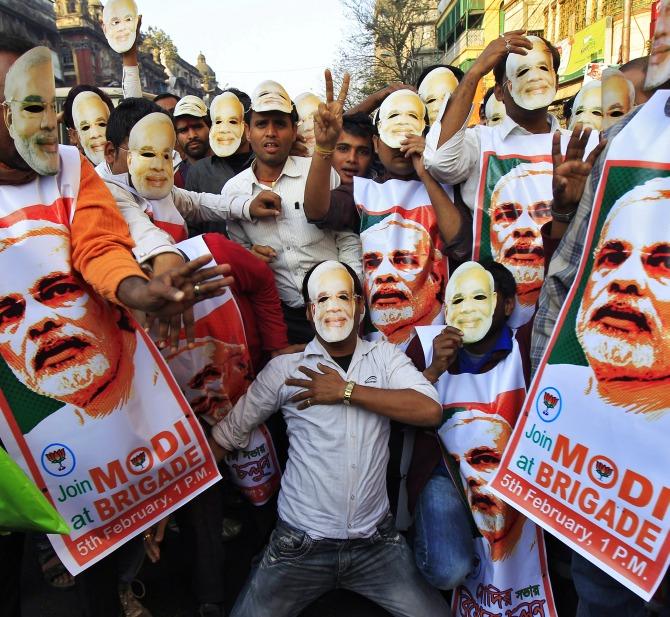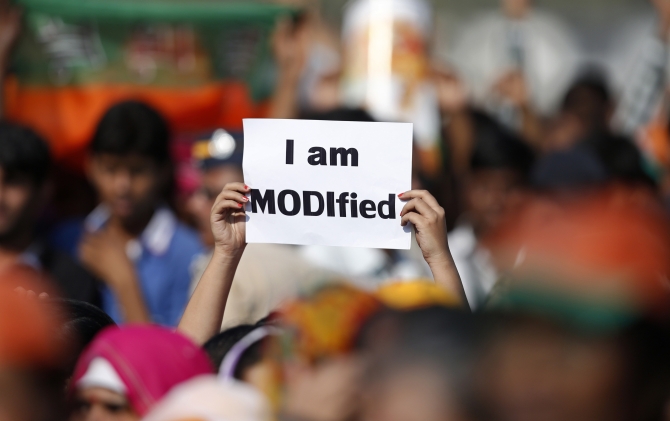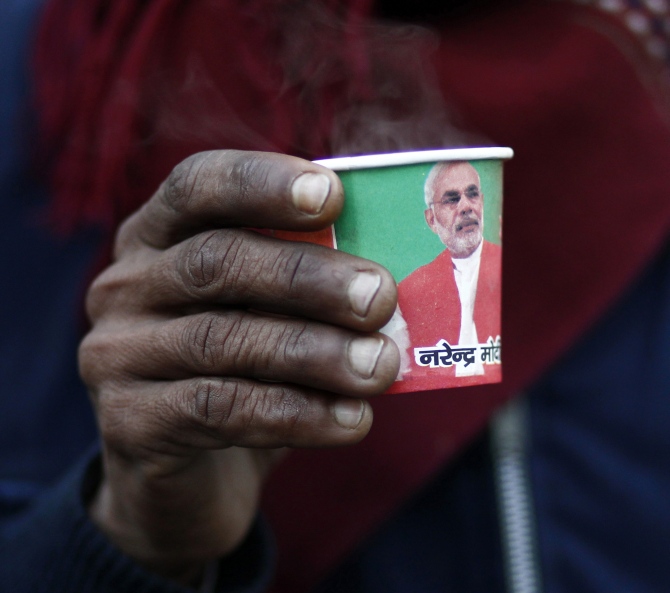Photographs: Rupak De Chowdhuri/Reuters Siddharth Mazumdar
The fact that Modi has not only been able to reach out but galvanise and engage productively with his young supporters is in many ways a game changer for old style Indian incestuous politics. May 16 could well prove that the road to Delhi is not via Lucknow or Patna but via ‘the youth’, says Siddharth Mazumdar
At the age of 63 one can hardly be called a youth icon. The white beard is even more incongruous to a youth generation often bracketed between 18 and 35. His nearest competitors to occupy this title, Arvind Kejriwal and Rahul Gandhi, are nearly two decades younger than him. Unarguably, Narendra Modi remains one of the most popular leaders amongst the country’s generation next, particularly amongst the first time voters.
Official estimates show that nearly 23 million first time voters are set to cast their franchise in elections due next month. At a time when opinion polls remain under the scanner, one fact all psephologists would agree is that the ‘first time voter block’ could be the single most decisive vote bank this elections.
Post-Independence, the space of a youth leader was conventionally captured by student leaders and young parliamentarians. Rajiv Gandhi’s ascendancy and the lowering of the voting age in his tenure marked a zenith in assuaging the aspirations of the youth. But in the last two decades, a culmination of several factors, has fundamentally redefined as to how generation next views its leadership.
Today student unions and their leadership have been reduced to defunct institutions and young lawmakers have become symbols of dynastic and incestuous politics. This perhaps explains while India becomes younger her youth leaders are not that young. Over the past decade A P J Abdul Kalam, Narayan Murthy and Narendra Modi have emerged as leaders who command immense good will amongst the youth.
...
'Vote bank' in a hurry
Image: Modi supporters hold BJP symbols during a rally being addressed by Modi in Chennai.Photographs: Babu/Reuters
Unlike other vote banks, which are usually united in a caste or ethnic identity, youth voters -- particularly the first time variants -- share a common passion of urgency. In an era where allegiance is defined by an instant ‘like’ or ‘follow’ button, the ability to deliver quickly takes precedence over most other factors.
Modi’s distinct image and track record of an efficient administrator -- known for taking quick decisions -- has contributed to his ability to excite young people like no politician in Indian history. His ‘Gujarat Model’ which built on the premise of managing the civil service with a private sector efficiency -- a tribe otherwise known for red tape -- resonates with a generation that has abandoned the lure for ‘mundane’ government jobs in exchange for the ‘dynamic’ private sector.
The youth traditionally identifies well the rebels. And in many ways Modi has risen from multiple rebellions. At a time when the media had nothing positive to report about him, he created an alternative communication channel -- a kind of first in Indian politics -- via the social media to connect with his audience. He trained his eyes on Delhi by keeping his feet firmly rooted to Gujarat, a strategy rarely adopted in our polity. And he also managed to engage with the mighty America on his own terms and condition through a rigour rarely displayed by any South Asian leader.
Propagating alternative politics
Image: A Modi supporter holds a placard during a rally in Mumbai.Photographs: Mansi Thapliyal/Reuters
India’s children of liberalisation are largely ignorant to the lofty ideals of socialism which our founding fathers had then deemed apt for us. Rather those born in the last three decades are most likely to attribute the genesis of the country’s problems to Nehruvian politics.
Globally the last three decades have seen the sharpening of right of centre politics -- from the US to UK to China -- but Indian polity has continued to remain left of centre. It is an irony that India’s longest serving non-Congress prime minster, Atal Bihari Vajpayee, was often called a modern day Nehruvian.
While most political leaders in India across the spectrum were still itchy to explicitly shake hands with capitalism, Modi’s open advocacy of less government and more governance, endorsing the private sector and a red carpet for global trade has perhaps jettisoned him as India’s first right of centre leader after C Rajagopalachari.
The five decade gap between the two leaders might explain why the youth -- which perceive the private sector has less corrupt than the public sector -- were quick to embrace him.
Apart from this pro-business image, Modi’s biggest youth connect has been his persistent effort to shift public discourse back to development and nation building. In a post-Mandal era when most of contemporaries chose to exploit caste and ethnic fault lines, Modi consciously kept away from that. When his critics tried to push him over the Gujarat riots for nearly a decade, his staunch silence proved to be his biggest defence especially in the aftermath of the Ahmedabad trial court verdict.
Political pundits of repute might consider such strategies damaging for different vote-banks, Modi’s India’s first slogan and his penchant to pursue ‘development politics over vote-bank politics’ appeal to a youth population are yet to see fruits of caste politics.
A key gravitation of Modi’s politics in attracting the youth has been his proficiency -- which has also become his trademark -- in raising the aspiration bar. At a time when the only hope his counterparts would offer is a ‘poverty free India’, Modi goes leaps ahead and enforces his view that India can beyond China.
When he airs his views on urbanisation he does restrict himself of revamping existing metros but rather makes a bold promise of building 100 new cities. Modi’s speech at Shri Ram College of Commerce early last year remains one such defining speeches which invigorated the urban and hyperactive Facebook user. While the validity of such promises need to be tested they do go a long away in firing the imagination of a restless and ambitious ‘vote bank’.
The fact that today’s campaign discourse is primarily about debating the ‘Gujarat Model’ in itself is a point how Modi has been successfully to an extent in bringing back the spotlight to development.
...
Giving a chance to outsiders
Image: A man holds a paper cup carrying a portrait of at a tea stall in the old quarters of Delhi.Photographs: Anindito Mukherjee/Reuters
Those who have had any interaction with Modi, including the author, would vouch for his ability to listen and be receptive to new ideas and dynamic individuals. (If one is not convinced by this than do try sending an email to his office and check your inbox in a few days to find a reply). Had his office been insular when few motivated and opinionated young individuals approached him a year back to contribute to India’s general elections, Citizens for Accountable Governance -- his campaign support team -- wouldn’t have existed.
Modi’s penchant for identifying new talent is changing the rules of election campaign. Through platforms such as CAG , thousands of ordinary and capably youngsters are getting a chance to shape the general elections which were normally restricted to those with either money or muscle power. A hallmark of Modi’s campaign has been that is not just run from Delhi, which points out a subtle democratisation of electioneering.
The fact that Modi has not only been able to reach out but galvanise and engage productively with his young supporters is in many ways a game changer for old style Indian incestuous politics. May 16 could well prove that the road to Delhi is not via Lucknow or Patna but via ‘the youth’.
Siddharth Mazumdar is founder member Citizens for Accountable Governance and author of the recent book, Moditva -- The Idea Behind the Man
TOP photo features you missed last week
Photographs: Anindito Mukherjee/Reuters
Click on MORE to see another PHOTO feature...





article